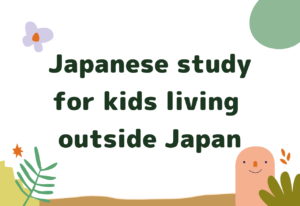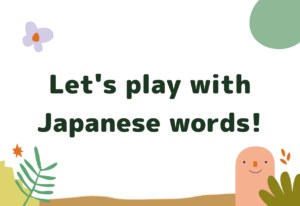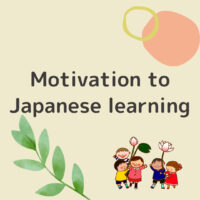

What is “heritage language”?
Have you ever heard of the term “heritage language”? In Japanese, it’s called “keisho-go”. You might not have many opportunities to hear the term in everyday life.
However, if you live overseas (outside of Japan) and would like your children to speak Japanese, the language of your family roots, you may be interested in this term.
Although there are a variety of definitions concerning “heritage language” proposed by different researchers/organizations. I would like to introduce here the one that I feel comfortable with.
A heritage language is the language associated with family and home, and in many cases, the language of a local community of speakers.
A heritage language is not the dominant language of the society; in particular, it is not the language of the educational system.*
In this sense, we can say “heritage language” is a topic with which parents living outside Japan are dealing and struggling on a daily basis if they wish their children speak Japanese.
Many children with roots in Japan are living abroad and studying Japanese. It is not easy for them to learn Japanese since Japanese is not the main language in their lives. While recognizing the difficulty for the children, I have the utmost respect for their parents who are trying to provide their children with a Japanese language environment. I am involved in Japanese language education for children living outside Japan, hoping to be close to the feelings of such families and to support them from a professional standpoint.
More precisely, I would like to prepare an environment where children can become interested in the Japanese language, Japanese culture and society, and Japan as a country. By doing so, I expect that children would consider and be proud of their roots and identity. I also hope that the environment would allow children to express their own opinions while thinking over their immediate surroundings and society.
Difficulties in continuous Japanese learning outside Japan
I have been involved in the education field for over 20 years. Throughout my career with going through trial and error processes, I have had opportunities of reflecting better learning for children in heritage languages as well as foreign languages in various countries.

In addition, my long years of living abroad allow me to encounter children who have roots in Japan but do not feel the need to learn Japanese.
The experience teaches me that both the children and their parents are looking for an answer to the question, “Why do we need to learn the heritage language when it is not necessary for our current lives?” While the parents desire their children not to forget the Japanese language, their children cannot find a concrete reason why they need to spend time for Japanese learning. It is not easy to bridge this gap, and I don’t think there is an absolute answer to this question, like a panacea.
In this environment, I am constantly asking myself how I can provide lessons that match the characteristics and circumstances of each child, and how I, as a Japanese language instructor, can support the parents who are struggling to make their children study Japanese.
Lessons that the children find “fun” and “useful”
It may seem basic, but unless we work together with the children to create lessons that they will find “fun” and “useful,” they will not be able to continue learning Japanese, nor will they be able to retain what they have learned.
I therefore would like to help children realize that learning and using Japanese can make their lives more enjoyable and enriching, and to provide an environment where they can continue their Japanese language study without too much difficulty.
Of course, I believe that such ingenious lessons are not something that can be achieved through “willingness/motivation” alone, but only through specialized knowledge and skills. With this understanding, I have kept updating my knowledge and skills so that I can create lessons that are meaningful to children.
In addition, I put the importance on project-based language learning** as a means of making children more engaged in Japanese language and culture in effective and meaningful ways. Project-based language learning is a method that aims to acquire language through the implementation of projects on predetermined themes.
* Definition from the University of California, Los Angeles, National Heritage Language Resource Center: https://nhlrc.ucla.edu/nhlrc/home
**Task-based language learning, similar to project-based language learning, will also be used depending on the situation.
There was an error obtaining the Benchmark signup form.
Feature articles
Archives
- August 2021 (1)
- July 2021 (1)
- June 2021 (4)






